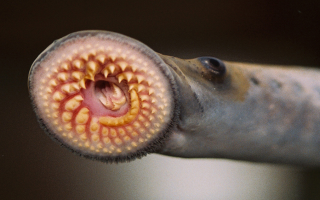Sea Lamprey

The sea lamprey (Petromyzon marinus) is an aggressive parasite that is considered a pest in many regions, including the U.S. Great Lakes. An ancient vertebrate, its lineage diverged from that of humans about 500 million years ago. They have remained largely unchanged for more than 340 million years and have survived through at least four major global extinction events. In 2013, the sea lamprey became the earliest vertebrate ancestor to have its whole genome sequenced and assembled.
Although classified in the subphylum Vertebrata, this species does not have vertebrae and its entire skeleton is cartilaginous. Sea lampreys are unique from many other fish species in that they do not have jaws or other bony structures. Instead, they possess a cartilaginous skeleton and a large oral disk filled with sharp, horn-shaped teeth that surround a toothed tongue.
Type: Vertebrate
Range: Native to the Northern Atlantic but now found in the Great Lakes and in Eastern Europe
Life Span in the Wild: 7-10 years
Size: Adults: 1-2 feet long
Weight: 0.5 – 1 pound
Diet: Carnivore, parasitic
Status: Species of Least Concern
Adult lamprey can feed on any species of fish provided there is sufficient area for them to attach. Adults use their sucker-like mouth to attach to their host and rasp out a hole with their rough tongue. An anticoagulant in their saliva prevents clotting.
Scientists around the world study lampreys as model for understanding the neural basis of vertebrate locomotion. MBL researchers study lampreys molecular understanding of human neurodegenerative disease and neurological disorders and to better understand the genetic basis of regeneration. The lamprey can fully regenerate its spinal cord even after it’s been severed — within 3 months the lamprey is swimming, burrowing, and flipping around as if it were never injured.
This amazing recovery is due to robust regeneration of nerve cells and their connections within the spinal cord.
In 2019, scientists at the MBL’s Eugene Bell Center for Regenerative Biology and Tissue Engineering found that lampreys recover and regenerate just as impressively after a second complete spinal cord injury at the same location—opening up a new path for identifying pro-regenerative molecules and potential therapeutic targets for human spinal cord injury.



